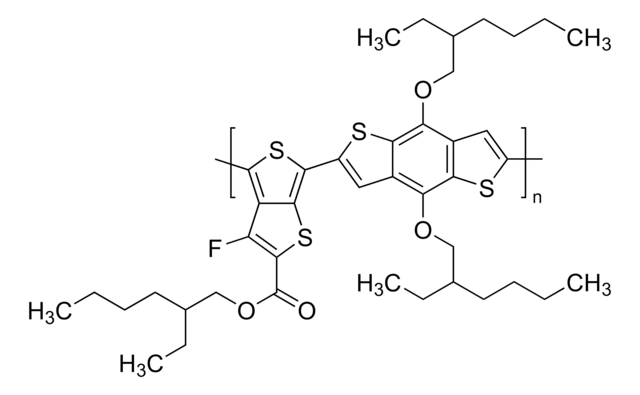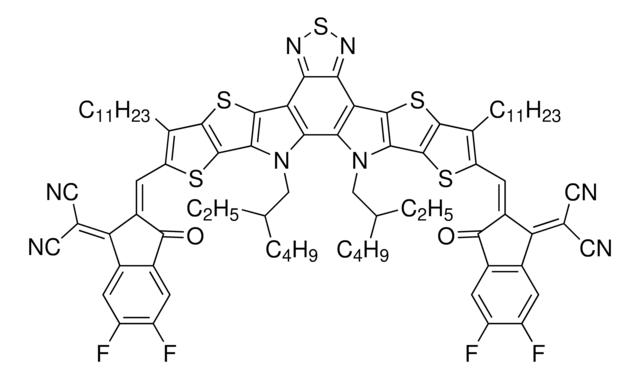753998
PCDTBT
Synonym(s):
Poly[N-9′-heptadecanyl-2,7-carbazole-alt-5,5-(4′,7′-di-2-thienyl-2′,1′,3′-benzothiadiazole)], Poly[[9-(1-octylnonyl)-9H-carbazole-2,7-diyl]-2,5-thiophenediyl-2,1,3-benzothiadiazole-4,7-diyl-2,5-thiophenediyl]
About This Item
Recommended Products
description
Band gap: 1.9 eV
form
solid
mol wt
average Mw 100,000-140,000
loss
0.5 wt. % TGA, 409 °C
mp
270-300 °C
transition temp
Tm >400 °C
λmax
576 nm
Orbital energy
HOMO -5.5 eV
LUMO -3.6 eV
OPV Device Performance
ITO/MoO3-Al/PCDTBT:PC71BM/MoO3/Al
- Short-circuit current density (Jsc): 10.88 mA/cm2
- Open-circuit voltage (Voc): 0.88 V
- Fill Factor (FF): 0.71
- Power Conversion Efficiency (PCE): 6.77 %
ITO/PEDOT:PSS/PCDTBT:PC71BM (1:4)/TiOxAl
- Short-circuit current density (Jsc): 11.32 mA/cm2
- Open-circuit voltage (Voc): 0.88 V
- Fill Factor (FF): 0.69
- Power Conversion Efficiency (PCE): 6.9 %
ITO/PEDOT:PSS/PCDTBT:PC71BM/Al
- Short-circuit current density (Jsc): 9.7 mA/cm2
- Open-circuit voltage (Voc): 0.82 V
- Fill Factor (FF): 0.61
- Power Conversion Efficiency (PCE): 5.3 %
semiconductor properties
P-type (mobility=6×10−5 cm2/V·s)
Looking for similar products? Visit Product Comparison Guide
General description
Application
Storage Class Code
11 - Combustible Solids
WGK
WGK 3
Flash Point(F)
Not applicable
Flash Point(C)
Not applicable
Choose from one of the most recent versions:
Already Own This Product?
Find documentation for the products that you have recently purchased in the Document Library.
Articles
The development of high-performance conjugated organic molecules and polymers has received widespread attention in industrial and academic research.
Organic materials in optoelectronic devices like LEDs and solar cells are of significant academic and commercial interest.
Organic materials in optoelectronic devices like LEDs and solar cells are of significant academic and commercial interest.
Organic materials in optoelectronic devices like LEDs and solar cells are of significant academic and commercial interest.
Active Filters
Our team of scientists has experience in all areas of research including Life Science, Material Science, Chemical Synthesis, Chromatography, Analytical and many others.
Contact Technical Service




![[6,6]-Phenyl C71 butyric acid methyl ester, mixture of isomers 99%](/deepweb/assets/sigmaaldrich/product/structures/716/624/9fb9f2f0-ae99-429f-8d3a-b12267976a4d/640/9fb9f2f0-ae99-429f-8d3a-b12267976a4d.png)



